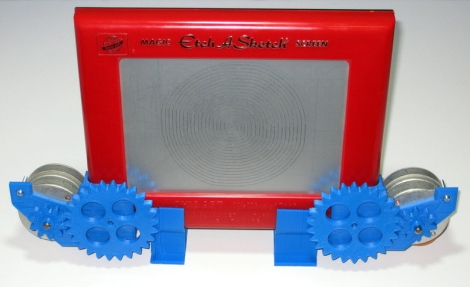
Having never been any good with an Etch-a-Sketch, [Ben] decided it was time to tame the children’s toy that had taunted him for so long. He received one in a gift exchange a few years back and hung onto it, recently digging it out again to fit it with some CNC components.
Using his RepRap, he printed a set of mounting plates and gears to drive the Etch-a-Sketch’s dials. He installed a pair of Airpax steppers to the gears and wired them up to an ATmega AT90 USB board he had sitting around. He installed RepRap firmware on the microcontroller, since it has a built-in gcode interpreter, making it easy for him to upload any gcode file to the Etch-a-Sketch for drawing.
You can see a quick demonstration of the device in action below. He converted a spiral image to gcode, then uploaded it to the Etch-a-Sketch – the machine does the rest. It draws pretty quickly as well – [Ben] even suggests that he could probably get it moving fast enough to melt the stylus!
It would be great to see the Etch-a-Sketch configured to support an online interface. That way he could allow people to upload images to the device, later showing off the artwork in a web gallery not unlike the LOL Shield Theatre we featured last week.
[via Make]
[youtube=http://www.youtube.com/watch?v=6UV05jmrK7k&w=470]
















Finally you´ve got a vector display :).
Now, just add a pair of encoders on the gears so that it can capture a drawing, and you’ve got it made!
Nice work. Sounds like a lot of backlash in the gears.
It’s amazing how he hacked the driver PCB together, I think that is more impressive than the hack itself
Nice work !
With the help of some 555, you could also have drawn a spiral ! (and maybe some other funny shapes) :)
do hackaday readers read hackaday?
http://hackaday.com/2009/05/13/massive-etch-a-sketch-from-tv-screen/
correction, i meant writers :)
@Dan
It’s called deadbug-style, a fast protyping technique for when you need something more robust than a breadboard
http://opencircuits.com/Dead_bug_style
It would be neat if he made the spirals without cnc software on a computer. You would need a VCF Sine generator circuit, signaled by a slow ramp function. The output sine signal can either be used to power a very linear transistor, or another vcf to control pwm/steps – this is one of the knob motors. If you plot sine against cosine against each other, you will notice it creates a perfect circle, so the other knob will need to be powered by the sine signal shifted by 90 degrees (a capacitor before a buffer stage might cut it). The ramp function is used to steadily increase the frequency of both signals so the circles gradually become smaller – creating a spiral.